Total Water Level Mitigation Related to Fringing Reef and Upperbeach Vegetation Status at a Hurricane Exposed Coast
Abstract
1. Introduction
2. Site Description and Observations
3. The Numerical Model
3.1. Model Description
3.2. Model Calibration
3.3. Model Strategy and Scenarios
3.3.1. Offshore Forcing
3.3.2. Ecosystem Status
3.3.3. Post-Processing Modeling Outputs
4. Results
4.1. Impact of Ecosystems Status on TWL2%
4.2. Influence of Ecosystems Status on TWL2% Components
5. Discussion
5.1. Coral Reef and Upperbeach Vegetation Impact on Coastal Flooding
5.2. Expectations for Changes in Coastal Flooding in the Future
5.3. Planning Recommendations
6. Conclusions
- Ecosystem degradation results in an increase in the TWL.
- Coral reef degradation leads to an increase in low-frequency motions in the nearshore area.
- The impact of the vegetation on the swash is dependent on the distance crossed by the flow.
- Combining a degraded coral reef and a healthier upperbeach vegetation induced an increase of TWL2% for low and moderate offshore conditions but an attenuation for the most extreme offshore conditions. So upperbeach vegetation could compensate for losses in the coral reef for the most extreme conditions.
- With both ecosystems having a healthier status, a reduced TWL by up to 0.7 m (25%).
- Further degradation of both ecosystems can lead to an increase in the TWL that can exceed 1 m can result.
- The sea-level rise will likely exceed the reef’s capacity to grow, as reefs will deepen and progressively lose their effect on wave attenuation even though they may have a high structural complexity.
- With the loss of reef protection, the relative effect of the upperbeach vegetation will increase assuming beach morphological adaptation occurs, that the vegetation retains its ability to resist the most extreme waves and the vegetation is able to recover rapidly.
Author Contributions
Funding
Institutional Review Board Statement
Informed Consent Statement
Data Availability Statement
Acknowledgments
Conflicts of Interest
References
- Guannel, G.; Ruggiero, P.; Faries, J.; Arkema, K.; Pinsky, M.; Gelfenbaum, G.; Guerry, A.; Kim, C.K. Integrated modeling framework to quantify the coastal protection services supplied by vegetation. J. Geophys. Res. Ocean. 2015, 120, 324–345. [Google Scholar] [CrossRef]
- Infantes, E.; Orfila, A.; Simarro, G.; Terrados, J.; Luhar, M.; Nepf, H. Effect of a seagrass (Posidonia oceanica) meadow on wave propagation. Mar. Ecol. Prog. Ser. 2012, 456, 63–72. [Google Scholar] [CrossRef]
- James, R.; Lynch, A.; Herman, P.; Katwijk, M.; Tussenbroek, B.; Dijkstra, H.; Westen, R.; Boog, C.; Klees, R.; Pietrzak, J.; et al. Tropical Biogeomorphic Seagrass Landscapes for Coastal Protection: Persistence and Wave Attenuation During Major Storms Events. Ecosystems 2021, 24, 301–318. [Google Scholar] [CrossRef]
- Maza, M.; Lara, J.; Losada, I.; Ondiviela, B.; Trinogga, J.; Bouma, T. Large-scale 3-D experiments of wave and current interaction with real vegetation. Part 2: Experimental analysis. Coast. Eng. 2015, 106, 73–86. [Google Scholar] [CrossRef]
- Anderson, M.; Smith, J.; McKay, S. Wave Dissipation by Vegetation; US Army Corps of Engineers Engineer Research and Development Center: Vicksburg, MS, USA, 2011; p. 22. [Google Scholar]
- Miller, T.; Gornish, E.; Buckley, H. Climate and coastal dune vegetation: Disturbance, recovery, and succession. Plant Ecol. 2010, 206, 97–104. [Google Scholar] [CrossRef]
- Evelpidou, N.; Petropoulos, A.; Karkani, A.; Saitis, G. Evidence of Coastal Changes in the West Coast of Naxos Island, Cyclades, Greece. J. Mar. Sci. Eng. 2021, 9, 1427. [Google Scholar] [CrossRef]
- Ferrario, F.; Beck, M.; Storlazzi, C.; Micheli, F.; Shepard, C.; Airoldi, L. The effectiveness of coral reefs for coastal hazard risk reduction and adaptation. Nat. Commun. 2014, 5, 3794. [Google Scholar] [CrossRef]
- Harris, D.; Rovere, A.; Casella, E.; Power, H.; Canavesio, R.; Collin, A.; Pomeroy, A.; Webster, J.; Parravicini, V. Coral reef structural complexity provides important coastal protection from waves under rising sea levels. Sci. Adv. 2018, 4, eaao4350. [Google Scholar] [CrossRef]
- Pearson, S.; Storlazzi, C.; Dongeren, A.; Tissier, M.; Reniers, A. A Bayesian-Based System to Assess Wave-Driven Flooding Hazards on Coral Reef-Lined Coasts. J. Geophys. Res. Ocean. 2017, 122, 10099–10117. [Google Scholar] [CrossRef]
- Quataert, E.; Storlazzi, C.; van Rooijen, A.; Cheriton, O.; van Dongeren, A. The influence of coral reefs and climate change on wave-driven flooding of tropical coastlines. Geophys. Res. Lett. 2015, 42, 6407–6415. [Google Scholar] [CrossRef]
- Storlazzi, C.; Elias, E.; Field, M.; Presto, M. Numerical modeling of the impact of sea-level rise on fringing coral reef hydrodynamics and sediment transport. Coral Reefs 2011, 30, 83–96. [Google Scholar] [CrossRef]
- Storlazzi, C.; Gingerich, S.; Dongeren, A.; Cheriton, O.; Swarzenski, P.; Quataert, E.; Voss, C.; Field, D.; Annamalai, H.; Piniak, G.; et al. Most atolls will be uninhabitable by the mid-21st century because of sea-level rise exacerbating wave-driven flooding. Sci. Adv. 2018, 4, eaap9741. [Google Scholar] [CrossRef] [PubMed]
- Beetham, E.; Kench, P.; O’Callaghan, J.; Popinet, S. Wave transformation and shoreline water level on Funafuti Atoll, Tuvalu Edward. J. Geophys. Res. Ocean. 2016, 121, 6762–6778. [Google Scholar] [CrossRef]
- Roeber, V.; Bricker, J. Destructive tsunami-like wave generated by surf beat over a coral reef during Typhoon Haiyan. Nat. Commun. 2015, 6, 7854. [Google Scholar] [CrossRef] [PubMed]
- Dongeren, A.; Lowe, R.; Pomeroy, A.; Trang, D.; Roelvink, D.; Symonds, G.; Ranasinghe, R. Numerical modeling of low-frequency wave dynamics over a fringing coral reef. Coast. Eng. 2013, 73, 178–190. [Google Scholar] [CrossRef]
- Beetham, E.; Kench, P. Predicting wave overtopping thresholds on coral reef-island shorelines with future sea-level rise. Nat. Commun. 2018, 9, 3997. [Google Scholar] [CrossRef]
- Bruch, W.; Cordier, E.; Floc’h, F.; G, P.S. Water Level Modulation of Wave Transformation, Setup and Runup over La Saline Fringing Reef. J. Geophys. Res. Ocean. 2022, 127, e2022JC018570. [Google Scholar] [CrossRef]
- Lashley, C.; Roelvink, D.; Dongeren, A.; Buckley, M.; Lowe, R. Nonhydrostatic and surfbeat model predictions of extreme wave run-up in fringing reef environments. Coast. Eng. 2018, 137, 11–27. [Google Scholar] [CrossRef]
- Quataert, E.; Storlazzi, C.; Dongeren, A.; McCall, R. The importance of explicitly modelling sea-swell waves for runup on reef-lined coasts. Coast. Eng. 2020, 160, 103704. [Google Scholar] [CrossRef]
- Rueda, A.; Cagigal, L.; Pearson, S.; Antolínez, J.; Storlazzi, C.; Dongeren, A.; Camus, P.; Mendez, F. HyCReWW: A Hybrid Coral Reef Wave and Water level metamodel. Comput. Geosci. 2019, 127, 85–90. [Google Scholar] [CrossRef]
- Astorga-Moar, A.; Baldock, T. Assessment and optimisation of runup formulae for beaches fronted by fringing reefs based on physical experiments. Coast. Eng. 2022, 176, 104163. [Google Scholar] [CrossRef]
- Franklin, G.; Torres-Freyermuth, A. On the runup parameterisation for reef-lined coasts. Ocean. Model. 2022, 169, 101929. [Google Scholar] [CrossRef]
- Roelvink, F.; Storlazzi, C.; Dongeren, A.; Pearson, S. Coral Reef Restorations Can Be Optimized to Reduce Coastal Flooding Hazards. Front. Mar. Sci. 2021, 8, 653945. [Google Scholar] [CrossRef]
- Storlazzi, C.D.; Reguero, B.G.; Cumming, K.A.; Cole, A.D.; Shope, J.B. Rigorously Valuing the Potential Coastal Hazard Risk Reduction Provided by Coral Reef Restoration in Florida and Puerto Rico. In U.S. Geological Survey; 2021; pp. 1–24. Available online: https://pubs.usgs.gov/of/2021/1054/ofr20211054.pdf (accessed on 13 March 2023).
- Grady, A.; Moore, L.; Storlazzi, C.; Elias, E.; Reidenbach, M. The influence of sea level rise and changes in fringing reef morphology on gradients in alongshore sediment transport. Geophys. Res. Lett. 2013, 40, 3096–3101. [Google Scholar] [CrossRef]
- Reguero, B.; Secaira, F.; Toimil, A.; Escudero, M.; Díaz-Simal, P.; Beck, M.; Silva, R.; Storlazzi, C.; Losada, I. The risk reduction benefits of the mesoamerican reef in Mexico. Front. Earth Sci. 2019, 7, 125. [Google Scholar] [CrossRef]
- Storlazzi, C.; Reguero, B.; Cole, A.; Lowe, E.; Shope, J.; Gibbs, A.; Nickel, B.; McCall, R.; Dongeren, A.; Beck, M. Rigorously Valuing the Role of U.S. Coral Reefs in Coastal Hazard Risk Reduction. Usgs Open-File Report 2019-1027, 42. 2019. Available online: https://pubs.er.usgs.gov/publication/ofr20191027 (accessed on 13 March 2023).
- Franklin, G.L.; Torres-Freyermuth, A.; Medellin, G.; Allende-Arandia, M.E.; Appendini, C.M. The role of the reef-dune system in coastal protection in Puerto Morelos (Mexico). Nat. Hazards Earth Syst. Sci. 2018, 18, 1247–1260. [Google Scholar] [CrossRef]
- Guannel, G.; Arkema, K.; Ruggiero, P.; Verutes, G. The power of three: Coral reefs, seagrasses and mangroves protect coastal regions and increase their resilience. PLoS ONE 2016, 11, e0158094. [Google Scholar] [CrossRef] [PubMed]
- Ellison, J. Pacific Island Beaches: Values, Threats and Rehabilitation. In Beach Management Tools—Concepts, Methodologies and Case Studies; Botero, C., Cervantes, O., Finkl, C., Eds.; Springer International Publishing: Berlin/Heidelberg, Germany, 2018; pp. 679–700. [Google Scholar] [CrossRef]
- Johnston, E.; Ellison, J. Evaluation of beach rehabilitation success, Turners Beach, Tasmania. J. Coast. Conserv. 2014, 18, 617–629. [Google Scholar] [CrossRef]
- CEREMA. Fiches Synthétiques de Mesure des États de Mer—Tome 3—Outre-Mer. 2021. Available online: https://www.cerema.fr/fr/centre-ressources/boutique/fiches-synthetiques-mesure-etats-mer-maj-2021 (accessed on 13 March 2023).
- Reguero, B.; Méndez, F.; Losada, I. Variability of multivariate wave climate in Latin America and the Caribbean. Glob. Planet. Chang. 2013, 100, 70–84. [Google Scholar] [CrossRef]
- Service Hydrographique et Océanographique de la Marine. Références Altimétriques Maritimes—Édition 2020. Online, 2020. Available online: https://diffusion.shom.fr/donnees/references-verticales/references-altimetriques-maritimes-ram.html (accessed on 13 March 2023).
- Laigre, T.; Balouin, Y.; Nicolae-Lerma, A.; Moisan, M.; Valentini, N.; Villaroel-Lamb, D.; Torre, Y. Seasonal and episodic runup variability on a Caribbean reef-lined beach. Authorea 2022. [Google Scholar] [CrossRef]
- Torres, R.; Tsimplis, M. Seasonal sea level cycle in the Caribbean Sea. J. Geophys. Res. Ocean. 2012, 117, 1–18. [Google Scholar] [CrossRef]
- Krien, Y.; Dudon, B.; Roger, J.; Zahibo, N. Probabilistic hurricane-induced storm surge hazard assessment in Guadeloupe, Lesser Antilles. Nat. Hazards Earth Syst. Sci. 2015, 15, 1711–1720. [Google Scholar] [CrossRef]
- Valentini, N.; Balouin, Y. Assessment of a smartphone-based camera system for coastal image segmentation and Sargassum monitoring. J. Mar. Sci. Eng. 2020, 8, 23. [Google Scholar] [CrossRef]
- Moisan, M.; Delahaye, T.; Laigre, T.; Valentini, N. Suivi des Échouages de Sargasse et de l’Évolution du Trait de côte par Caméra Autonome en Guadeloupe: Analyse des RÉsultats et Bilan des Observations. Rapport Final. In BRGM/RP-712-FR; 2021; Available online: http://ficheinfoterre.brgm.fr/document/RP-71295-FR (accessed on 13 March 2023).
- Roelvink, D.; Reniers, A.; Dongeren, A.; Vries, J.; McCall, R.; Lescinski, J. Modelling storm impacts on beaches, dunes and barrier islands. Coast. Eng. 2009, 56, 1133–1152. [Google Scholar] [CrossRef]
- Rooijen, V.; Dongeren, V.; Version, D.; Research-oceans, J.; Rooijen, V.; Dongeren, V. Modeling the effect of wave-vegetation interaction on wave setup. J. Geophys. Res. Ocean. 2016, 121, 4341–4359. [Google Scholar] [CrossRef]
- Buckley, M.; Lowe, R.; Hansen, J.; Dongeren, A. Dynamics of wave setup over a steeply sloping fringing reef. J. Phys. Oceanogr. 2015, 45, 3005–3023. [Google Scholar] [CrossRef]
- Roelvink, D.; McCall, R.; Mehvar, S.; Nederhoff, K.; Dastgheib, A. Improving predictions of swash dynamics in XBeach: The role of groupiness and incident-band runup. Coast. Eng. 2018, 134, 103–123. [Google Scholar] [CrossRef]
- Péquignet, A.; Becker, J.; Merrifield, M.; Boc, S. The dissipation of wind wave energy across a fringing reef at Ipan. Guam. Coral Reefs 2011, 30, 71–82. [Google Scholar] [CrossRef]
- Risandi, J.; Rijnsdorp, D.; Hansen, J.; Lowe, R. Hydrodynamic modeling of a reef-fringed pocket beach using a phase-resolved non-hydrostatic model. J. Mar. Sci. Eng. 2020, 8, 877. [Google Scholar] [CrossRef]
- Suzuki, T.; Hu, Z.; Kumada, K.; Phan, L.; Zijlema, M. Non-hydrostatic modeling of drag, inertia and porous effects in wave propagation over dense vegetation fields. Coast. Eng. 2019, 149, 49–64. [Google Scholar] [CrossRef]
- Tang, J.; Shen, S.; Wang, H. Numerical model for coastal wave propagation through mild slope zone in the presence of rigid vegetation. Coast. Eng. 2015, 97, 53–59. [Google Scholar] [CrossRef]
- SHOM. LITTO3D® Guadeloupe. 2016. Available online: https://diffusion.shom.fr/donnees/altimetrie-littorale/litto3d-guad2016.html (accessed on 13 March 2023).
- Maximiliano-Cordova, C.; Salgado, K.; Martínez, M.; Mendoza, E.; Silva, R.; Guevara, R.; Feagin, R. Does the Functional Richness of Plants Reduce Wave Erosion on Embryo Coastal Dunes? Estuaries Coasts 2019, 42, 1730–1741. [Google Scholar] [CrossRef]
- Le Cozannet, G.; Idier, D.; Michele, M.; Legendre, Y.; Moisan, M.; Pedreros, R.; Rc, D. Timescales of emergence of chronic flooding in the major economic center of Guadeloupe. Nat. Hazards Earth Syst. Sci. 2021, 21, 703–722. [Google Scholar] [CrossRef]
- Buddemeier, R.; Smith, S. Coral reef growth in an era of rapidly rising sea level: Predictions and suggestions for long-term research. Coral Reefs 1988, 7, 51–56. [Google Scholar] [CrossRef]
- Lange, I.; Perry, C. A quick, easy and non-invasive method to quantify coral growth rates using photogrammetry and 3D model comparisons. Methods Ecol. Evol. 2020, 11, 714–726. [Google Scholar] [CrossRef]
- Pratchett, M.S.; Anderson, K.D.; Hoogenboom, M.O.; Widman, E.; Baird, A.H.; Pandolfi, J.M.; Edmunds, P.J.; Lough, J.M. Spatial, temporal and taxonomic variation in coral growth—Implications for the structure and function of coral reef ecosystems. Oceanogr. Mar. Biol. 2015, 53, 215–295. [Google Scholar] [CrossRef]
- Yates, K.; Zawada, D.; Smiley, N.; Tiling-Range, G. Divergence of seafloor elevation and sea level rise in coral reef ecosystems. Biogeosciences 2017, 14, 1739–1772. [Google Scholar] [CrossRef]
- Cheriton, O.; Storlazzi, C.; Rosenberger, K. Observations of wave transformation over a fringing coral reef and the importance of low-frequency waves and offshore water levels to runup, overwash, and coastal flooding. J. Geophys. Res. Ocean. 2016, 121, 3121–3140. [Google Scholar] [CrossRef]
- Cheriton, O.; Storlazzi, C.; Rosenberger, K. In situ Observations of Wave Transformation and Infragravity Bore Development Across Reef Flats of Varying Geomorphology. Front. Mar. Sci. 2020, 7, 351. [Google Scholar] [CrossRef]
- Péquignet, A.C.; Becker, J.; Merrifield, M. Energy transfer between wind waves and low-frequency oscillations on a fringing reef, Ipan, Guam. J. Geophys. Res. Ocean. 2014, 119, 6121–6139. [Google Scholar] [CrossRef]
- Ma, G.; Su, S.; Liu, S.; Chu, J. Numerical simulation of infragravity waves in fringing reefs using a shock-capturing non-hydrostatic model. Ocean. Eng. 2014, 85, 54–64. [Google Scholar] [CrossRef]
- Buckley, M.L.; Lowe, R.J.; Hansen, J.E.; van Dongeren, A.R.; Storlazzi, C.D. Mechanisms of Wave-Driven Water Level Variability on Reef-Fringed Coastlines. J. Geophys. Res. Ocean. 2018, 123, 3811–3831. [Google Scholar] [CrossRef]
- Innocenti, R.A.; Feagin, R.A.; Charbonneau, B.R.; Figlus, J.; Lomonaco, P.; Wengrove, M.; Puleo, J.; Huff, T.P.; Rafati, Y.; Hsu, T.J.; et al. The effects of plant structure and flow properties on the physical response of coastal dune plants to wind and wave run-up. Estuarine Coast. Shelf Sci. 2021, 261, 107556. [Google Scholar] [CrossRef]
- Mazda, Y.; Wolanski, E.; King, B.; Sase, A.; Ohtsuka, D.; Magi, M. Drag force due to vegetation in mangrove swamps. Mangroves Salt Marshes 1997, 1, 193–199. [Google Scholar] [CrossRef]
- Kench, P.; Beetham, E.; Turner, T.; Morgan, K.; Mclean, R.; Owen, S. Sustained coral reef growth in the critical wave dissipation zone of a Maldivian atoll. Commun. Earth Environ. 2022, 3, 9. [Google Scholar] [CrossRef]
- Woesik, R.; Cacciapaglia, C. Keeping up with sea-level rise: Carbonate production rates in Palau and Yap, western Pacific Ocean. PLoS ONE 2018, 13, e0197077. [Google Scholar] [CrossRef]
- Perry, C.; Murphy, G.; Kench, P.; Smithers, S.; Edinger, E.; Steneck, R.; Mumby, P. Caribbean-wide decline in carbonate production threatens coral reef growth. Nat. Commun. 2013, 4, 1402. [Google Scholar] [CrossRef]
- Gardner, T.A.; Côté, I.M.; Gill, J.A.; Grant, A.; Watkinson, A.R. Long-term region-wide declines in Caribbean corals. Science 2003, 301, 958–960. [Google Scholar] [CrossRef]
- Wilkinson, C.; Souter, D. Status of Caribbean Coral Reefs after Bleaching and Hurricanes in 2005. In Proceedings of the © Global Coral Reef Monitoring Network. 2008. Available online: https://www.coris.noaa.gov/activities/caribbean_rpt/SCRBH2005_rpt.pdf (accessed on 13 March 2023).
- Bayraktarov, E.; Stewart-Sinclair, P.; Brisbane, S.; Boström-Einarsson, L.; Saunders, M.; Lovelock, C.; Possingham, H.; Mumby, P.; Wilson, K. Motivations, success, and cost of coral reef restoration. Restor. Ecol. 2019, 27, 981–991. [Google Scholar] [CrossRef]
- Omori, M. Coral restoration research and technical developments: What we have learned so far. Mar. Biol. Res. 2019, 15, 377–409. [Google Scholar] [CrossRef]
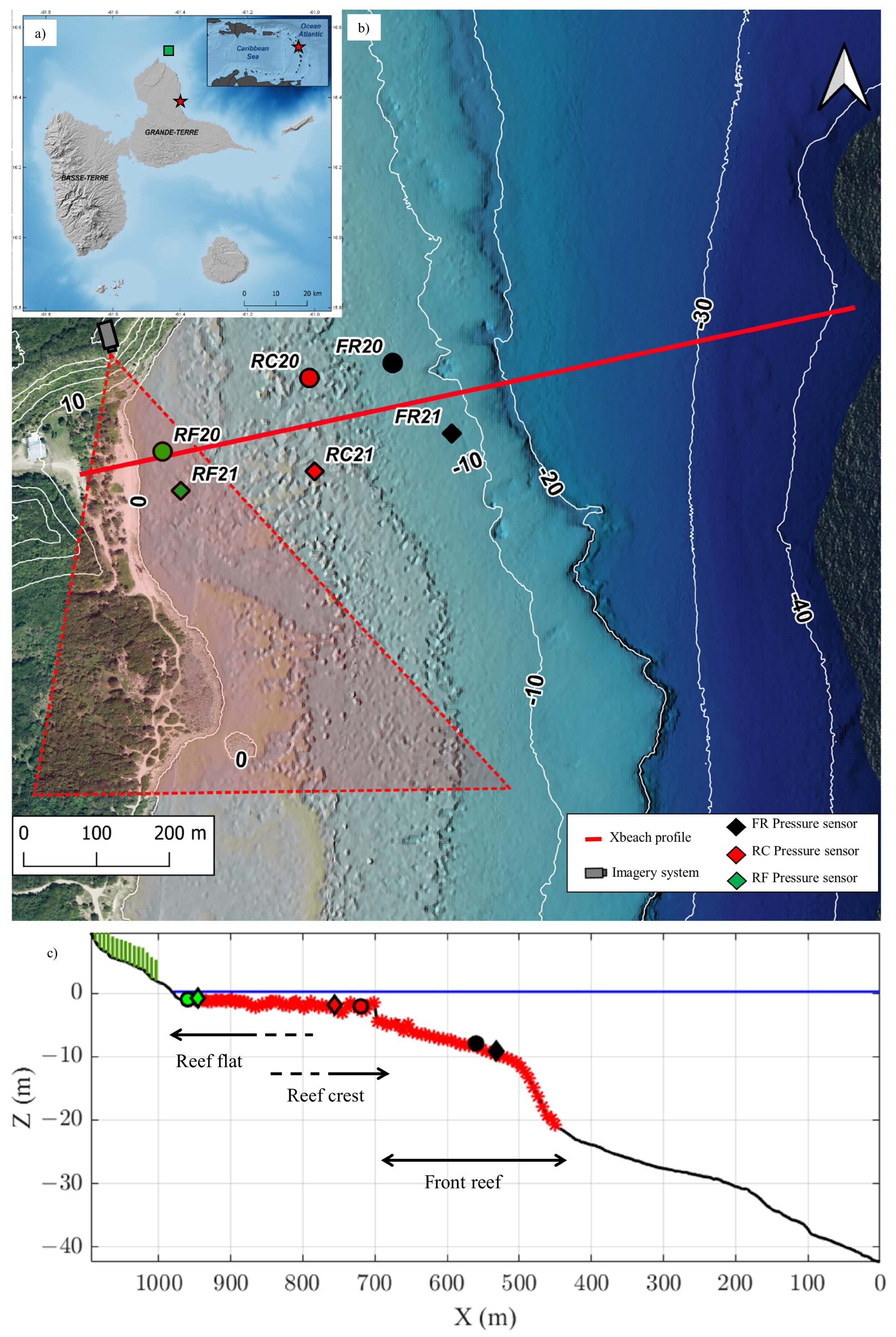
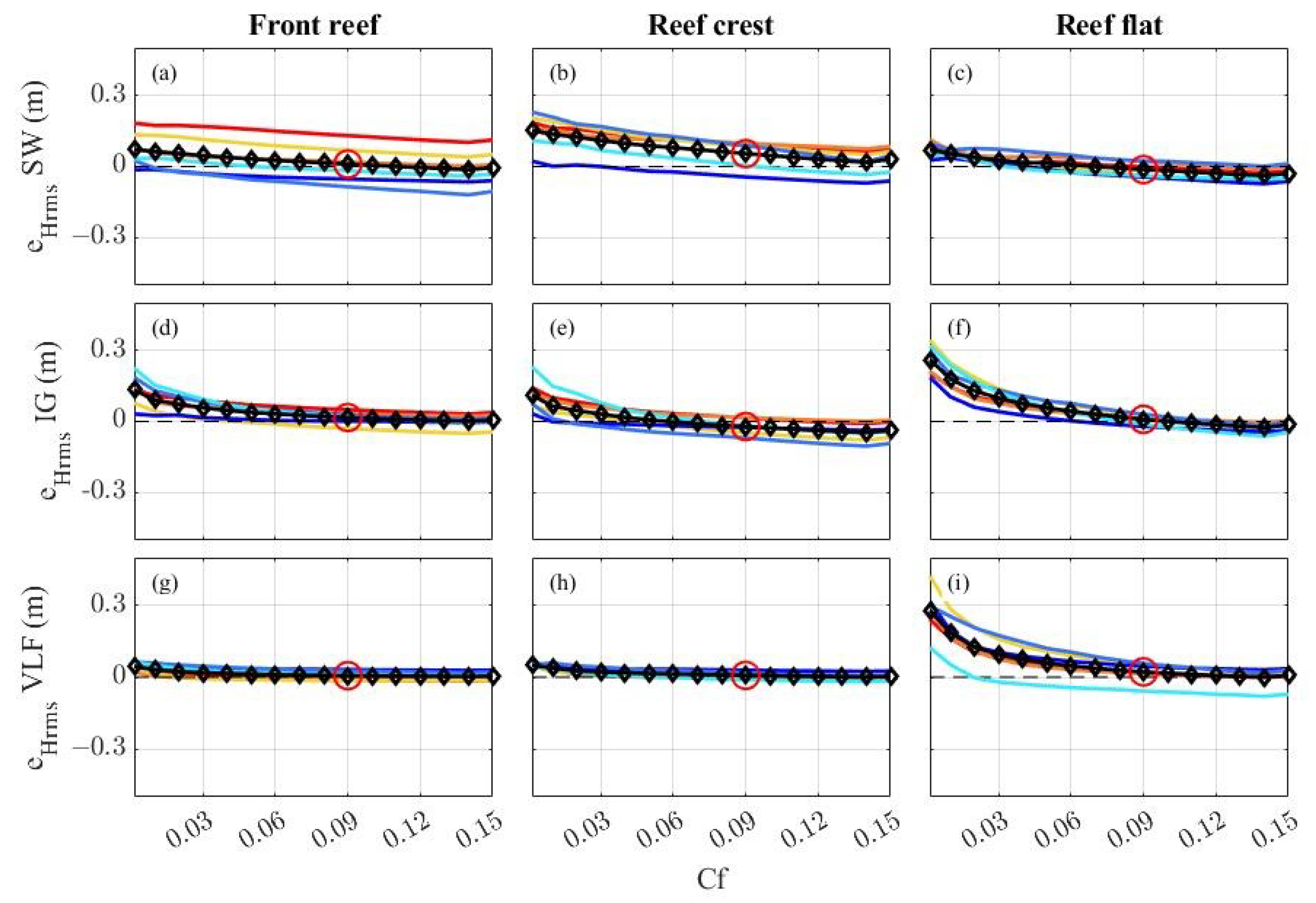
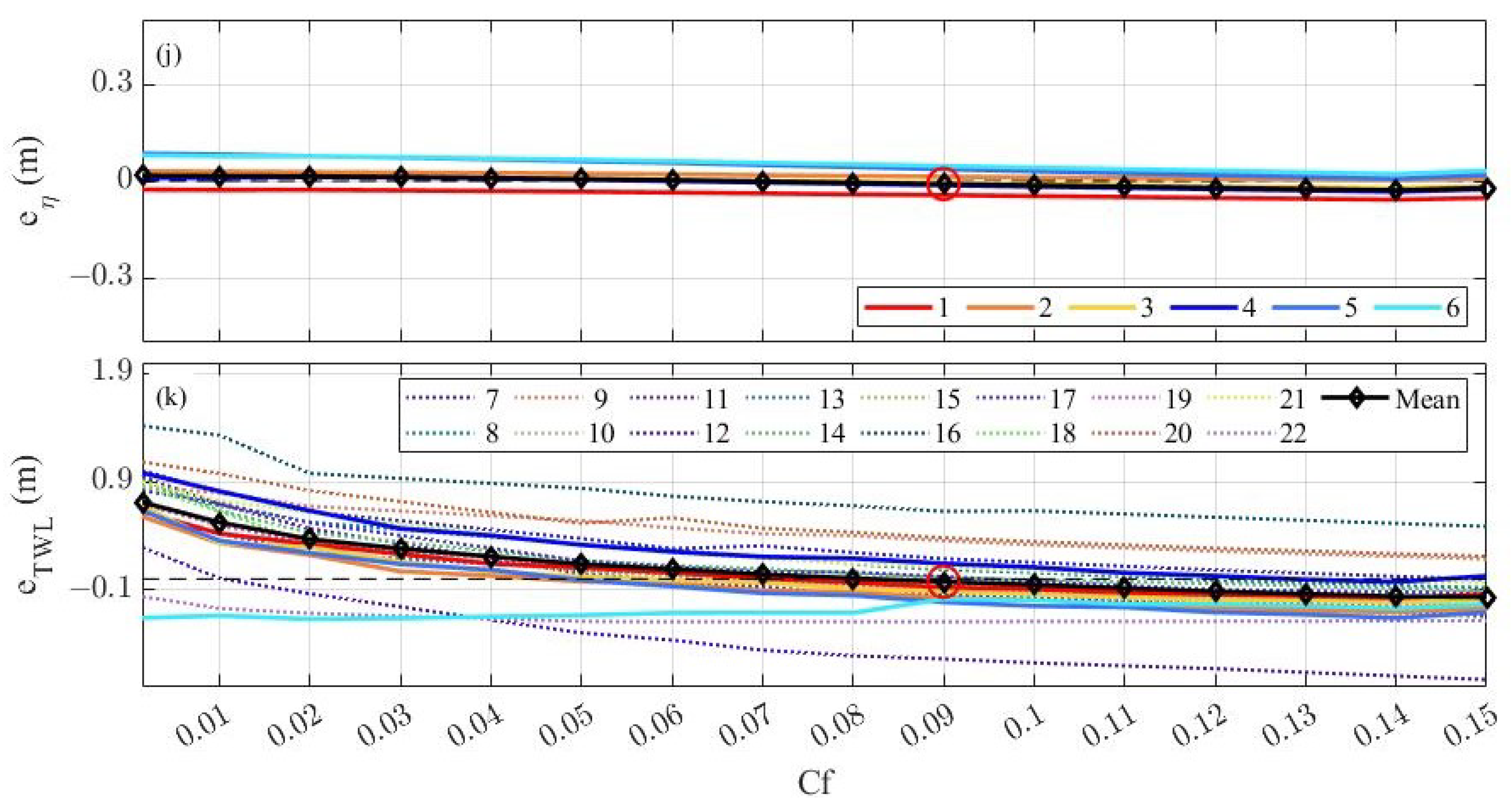
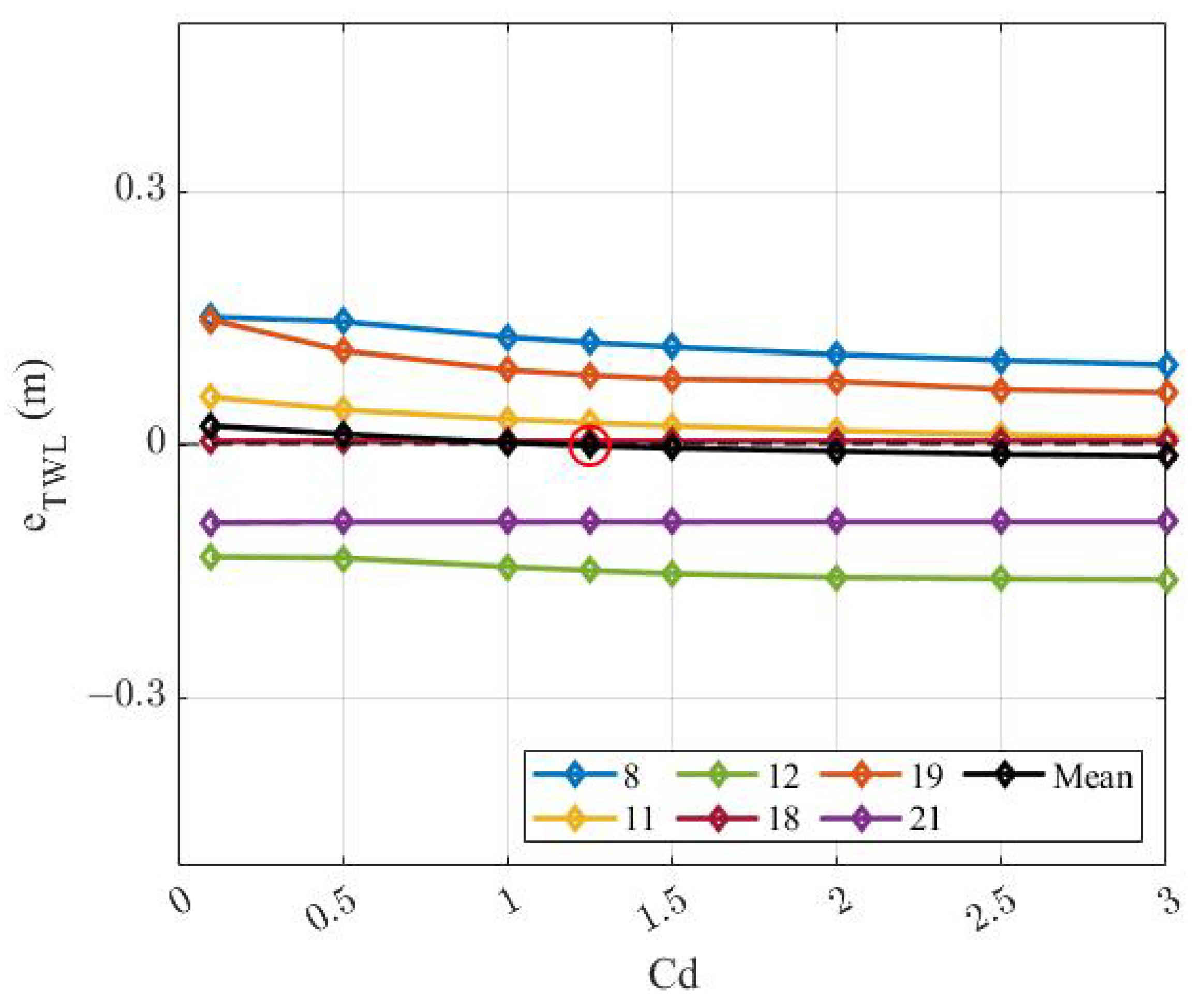


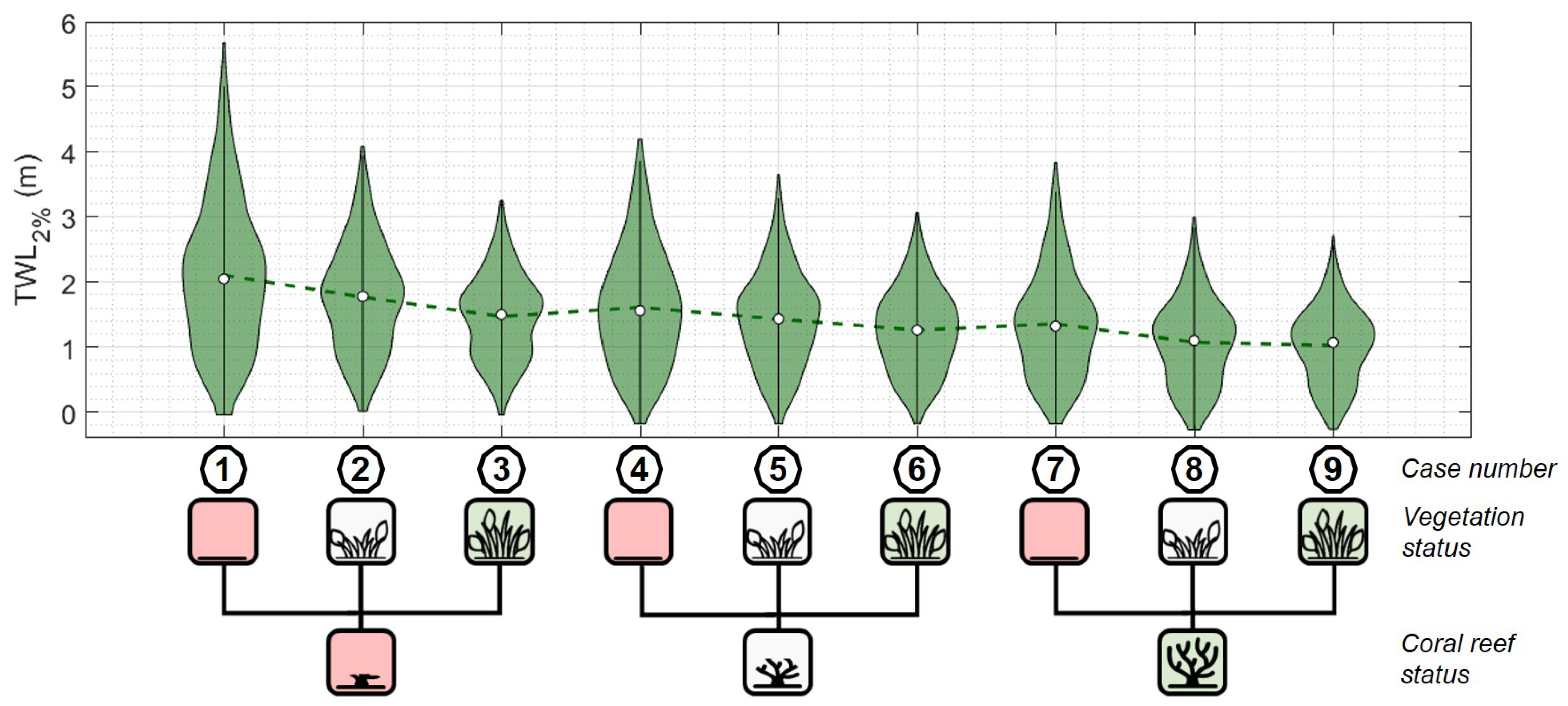
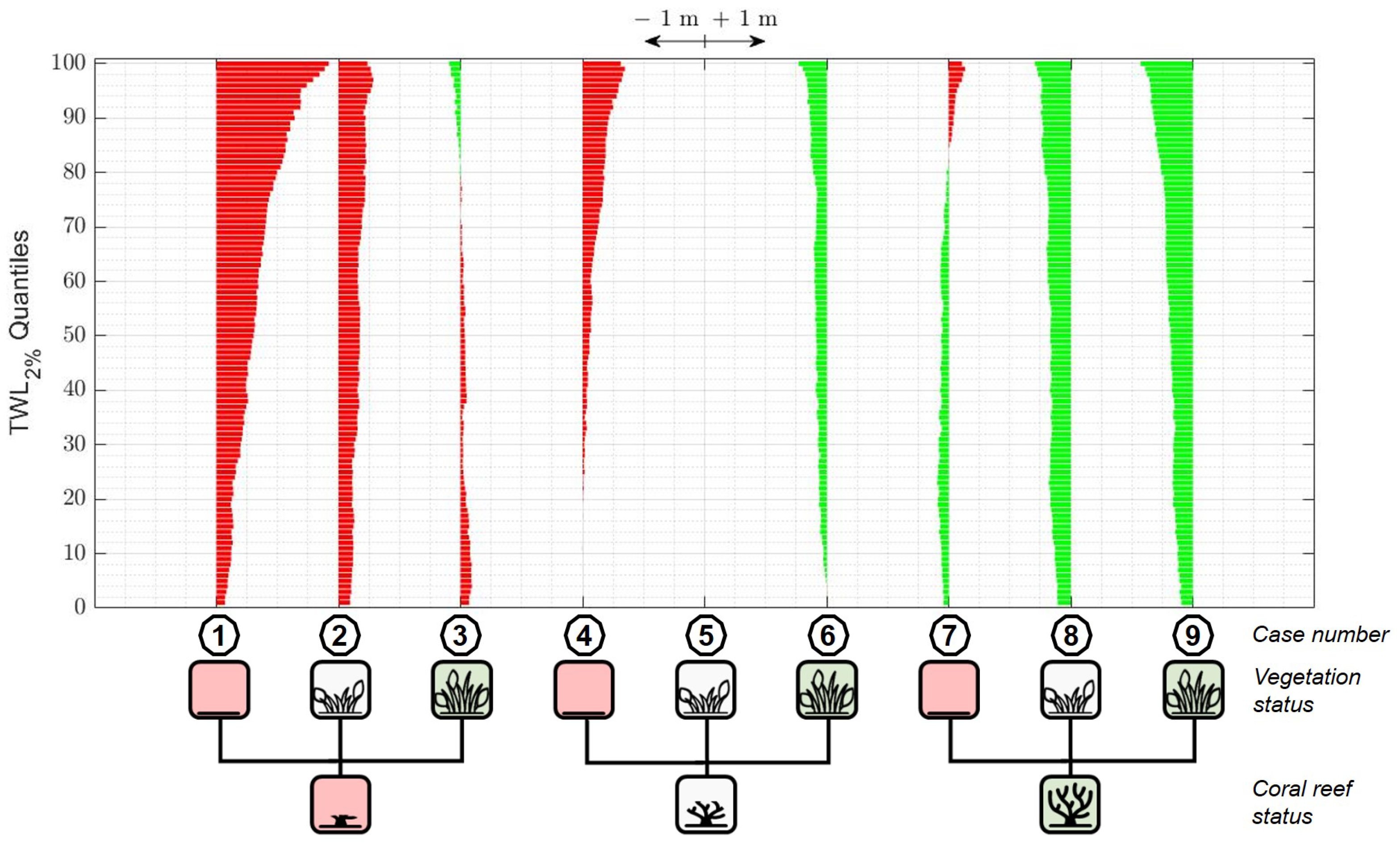

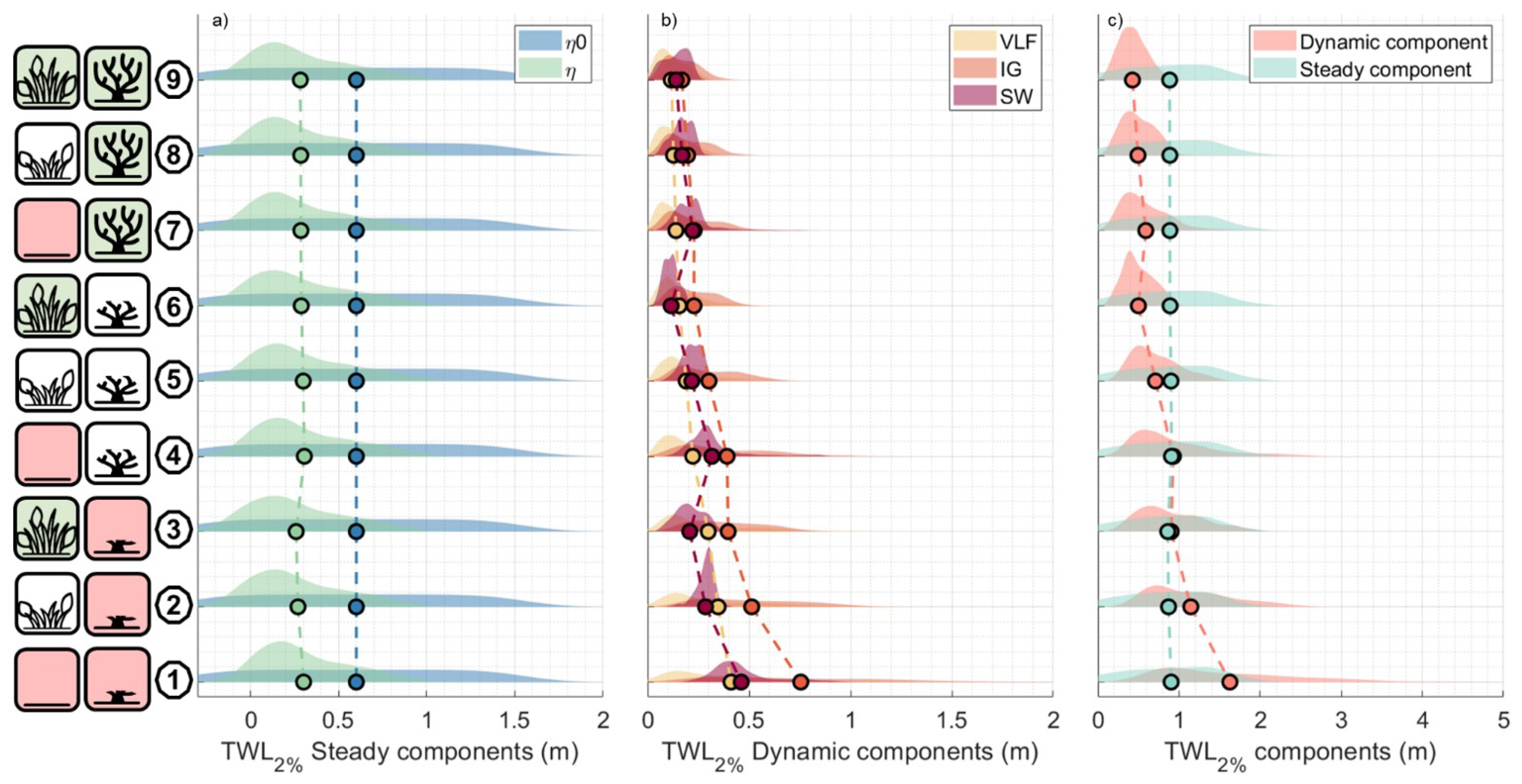

| Peak Conditions | ||||||
|---|---|---|---|---|---|---|
| Event id | Peak Date | 0 (m) | (m) | (s) | (°) | dTWL (m) |
| 1 | 2 October 2020 21 h | 0.27 | 2.27 | 8.77 | 73.00 | 0.80 |
| 2 | 15 October 2020 21 h | 0.23 | 1.78 | 7.94 | 80.00 | 0.80 |
| 3 | 29 October 2020 21 h | 0.18 | 2.39 | 9.01 | 81.00 | 0.90 |
| 4 | 28 August 2021 21 h | 0.30 | 1.79 | 8.13 | 72.00 | 0.65 |
| 5 | 6 September 2021 21 h | 0.25 | 2.94 | 9.56 | 75.00 | 0.60 |
| 6 | 30 September 2021 21 h | 0.25 | 2.08 | 11.63 | 67.00 | 0.60 |
| 7 | 17 December 2019 21 h | 0.22 | 2.63 | 9.43 | 72.00 | 0.63 |
| 8 | 13 January 2020 15 h | 0.04 | 3.63 | 10.64 | 63.00 | 0.78 |
| 9 | 8 February 2020 18 h | 0.22 | 2.68 | 8.47 | 71.00 | 0.45 |
| 10 | 25 July 2020 12 h | 0.32 | 2.30 | 8.77 | 70.00 | 0.92 |
| 11 | 29 July 2020 15 h | 0.25 | 3.62 | 11.11 | 80.00 | 1.07 |
| 12 | 19 September 2020 00 h | 0.18 | 3.33 | 12.26 | 75.00 | 1.54 |
| 13 | 24 December 2020 18 h | 0.34 | 2.49 | 8.77 | 72.00 | 0.70 |
| 14 | 1 January 2021 03 h | −0.11 | 3.06 | 9.09 | 48.00 | 0.52 |
| 15 | 18 February 2021 15 h | −0.03 | 2.65 | 8.70 | 70.00 | 0.20 |
| 16 | 28 February 2021 15 h | −0.20 | 2.42 | 8.40 | 69.00 | 0.12 |
| 17 | 31 March 2021 06 h | 0.17 | 2.45 | 9.01 | 78.00 | 0.70 |
| 18 | 17 June 2021 15 h | 0.28 | 2.45 | 8.62 | 74.00 | 0.88 |
| 19 | 2 July 2021 18 h | 0.14 | 3.36 | 9.17 | 80.00 | 0.70 |
| 20 | 12 July 2021 00 h | 0.21 | 2.00 | 9.00 | 83.00 | 0.52 |
| 21 | 23 August 2021 06 h | 0.42 | 2.32 | 8.40 | 68.00 | 0.75 |
| 22 | 18 December 2021 09 h | 0.17 | 2.60 | 9.35 | 75.00 | 0.57 |
Disclaimer/Publisher’s Note: The statements, opinions and data contained in all publications are solely those of the individual author(s) and contributor(s) and not of MDPI and/or the editor(s). MDPI and/or the editor(s) disclaim responsibility for any injury to people or property resulting from any ideas, methods, instructions or products referred to in the content. |
© 2023 by the authors. Licensee MDPI, Basel, Switzerland. This article is an open access article distributed under the terms and conditions of the Creative Commons Attribution (CC BY) license (https://creativecommons.org/licenses/by/4.0/).
Share and Cite
Laigre, T.; Balouin, Y.; Villarroel-Lamb, D.; Lerma, A.N.; Valentini, N.; Moisan, M.; De La Torre, Y. Total Water Level Mitigation Related to Fringing Reef and Upperbeach Vegetation Status at a Hurricane Exposed Coast. J. Mar. Sci. Eng. 2023, 11, 620. https://doi.org/10.3390/jmse11030620
Laigre T, Balouin Y, Villarroel-Lamb D, Lerma AN, Valentini N, Moisan M, De La Torre Y. Total Water Level Mitigation Related to Fringing Reef and Upperbeach Vegetation Status at a Hurricane Exposed Coast. Journal of Marine Science and Engineering. 2023; 11(3):620. https://doi.org/10.3390/jmse11030620
Chicago/Turabian StyleLaigre, Thibault, Yann Balouin, Deborah Villarroel-Lamb, Alexandre Nicolae Lerma, Nico Valentini, Manuel Moisan, and Ywenn De La Torre. 2023. "Total Water Level Mitigation Related to Fringing Reef and Upperbeach Vegetation Status at a Hurricane Exposed Coast" Journal of Marine Science and Engineering 11, no. 3: 620. https://doi.org/10.3390/jmse11030620
APA StyleLaigre, T., Balouin, Y., Villarroel-Lamb, D., Lerma, A. N., Valentini, N., Moisan, M., & De La Torre, Y. (2023). Total Water Level Mitigation Related to Fringing Reef and Upperbeach Vegetation Status at a Hurricane Exposed Coast. Journal of Marine Science and Engineering, 11(3), 620. https://doi.org/10.3390/jmse11030620








